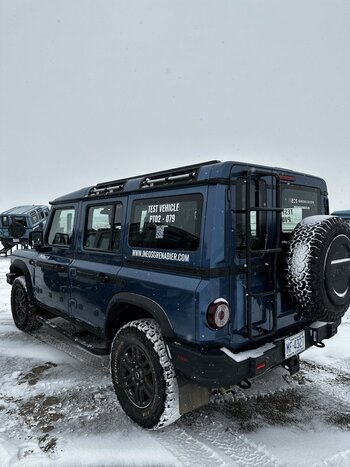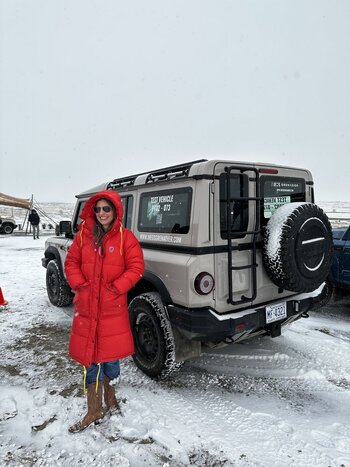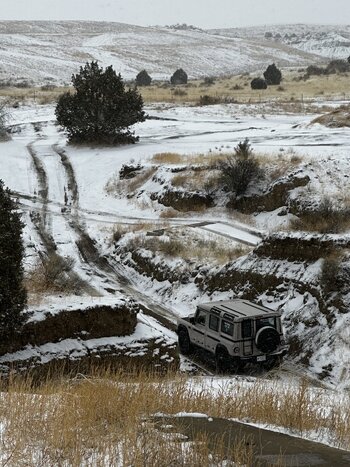I think we spoke briefly. I was the big fat guy in a Red Titelist hat and black coat. Brought my big camera, but with out being about to take internal pics or videos, was kid of useless. Plenty of exterior shots, and the lighting was crap.Finished my experience yesterday… pretty spectacular experience overall. We were told under no circumstance should we take or post video of the interior. Guy that road with us was very knowledgeable and was able to speak to all my questions. My daughter thinks she’ll get to drive it… haha!
View attachment 7809208
The Grenadier Forum
Register a free account today to become a member! Once signed in, you'll be able to contribute to the community by adding your own topics, posts, and connect with other members through your own private inbox! INEOS Agents, Dealers or Commercial vendors please contact admin@theineosforum.com for a commercial account.
You are using an out of date browser. It may not display this or other websites correctly.
You should upgrade or use an alternative browser.
You should upgrade or use an alternative browser.
USA Grenadier Experience (Denver, Colorado Region April 20-22)
- Thread starter Stu_Barnes
- Start date
Test drive confirmed that Grenadier is a very capable off roader and I think will be quite a versatile all-rounder. I felt very comfortable in the driver’s seat. I am going to convert my reservation to an order 100%.
Unfortunately neither of our two top color choices were present in the fleet (Sela Green and Queens Red). To my surprise Scottish White looks pretty good but my wife did not care for it so we will have to pick Queens Red or Sela Green based on photos videos.
Other than that we are looking forward to taking delivery in about a year. I think that might be a realistic timeframe.
Unfortunately neither of our two top color choices were present in the fleet (Sela Green and Queens Red). To my surprise Scottish White looks pretty good but my wife did not care for it so we will have to pick Queens Red or Sela Green based on photos videos.
Other than that we are looking forward to taking delivery in about a year. I think that might be a realistic timeframe.
- Local time
- 6:56 PM
- Joined
- Nov 14, 2021
- Messages
- 1,176
I went to the driving event at the Ram Off-Road Park in Colorado Springs on Friday. I got there early, and they let me drive the course before my appointment (I was the only car on the course), and then they let me drive it a second time during my scheduled appointment. These were my impressions:
The staff was great: professional, knowledgeable, and friendly.
The course was good - but not great. There was a 35-37 degree side-slope, a couple of short steep hills to both climb and descend, some tight turns, but nothing very technical. It was a more challenging course than most manufacturers would embrace, but if you regularly drive off-road in Colorado, this was about a 4 on the OnX Off Road scale from 0-10.
Here are my impressions. These may - or may not - be relevant to you. You may - or may not - use your off-road vehicle the same way that I do.
Positive impressions:
1. The Grenadier handled it all very well, and felt very planted - especially on the side slope.
2. The suspension is fantastic. Wheel travel is good, it articulates well, and the springs and shocks work well together to mitigate rough terrain. The Grenadier is comfortable and quiet off-road.
3. The steering felt precise off-road. We were in 4-low the whole time, and never got up to speed, so I cannot speak to on-road driving characteristics.
4. The B58 (gas engine) has excellent low-end torque, and is easy to modulate in low-range. This engine will out-perform all naturally aspirated 6-cylinder engines here at altitude. To compete at altitude, Jeep desperately needs an option for a forced induction 6 in the Wrangler/Gladiator, and Toyota needs a better powerplant for the Tacoma/4-Runner.
5. This little truck is solid. (a) The frame resembles that of a heavy duty pickup (e.g. Ford F250, Ram 2500); (b) The running gear (tie rod, drag link, track bar) resemble what you would see on a solid front axle Landcruiser - much beefier than a Jeep Wrangler, but not quite as stout as a heavy duty truck; (c) the axles are beefier than a Jeep Wrangler, but less stout than a heavy duty truck.
6. All moving parts in the body are aluminum (hood, four side doors, two rear doors). All the doors feel well-made, and close with a satisfying feel, that speaks to how well-sealed they are against the elements.
Not-so positive impressions:
1. I would have liked to engage and disengage the lockers, and I would have liked to shift in and out of 4-low. This was not permitted.
2. Given its clear intention to be a rugged 4x4, the Grenadier has good - but not great ground clearance. Most drivers were hitting the rear differential on a rock that wasn't very big (in Colorado, we regularly travel through much more rocky terrain). The Ineos guides requested that people either take it very slow, or place a tire on the rock (as opposed to straddling it). Placing tires on top of rocks is basic off-roading, but on harder trails, you need better ground clearance. If the Grenadier were more easily modified, this would not be a concern. However, as discussed in multiple threads on this forum, the Grenadier will not take well to larger tires for the following reasons: (a) short control arms, (b) lack of re-gearing options for the Carraro axles, and (c) a split rear door that will not accommodate a tire larger than 33-inches in diameter. Some - or all - of this may get addressed in the aftermarket.
3. Engine braking going down steep hills is good, but not great. For my style of off-road driving, I would prefer a lower, low range. The Grenadier has a low range of 2.5:1, whereas as a Wrangler Rubicon has a low-range of 4:1. The Rubicon transfer case is better-suited to technical off-road driving in Colorado. The Grenadier transfer case will be better for sand, and higher speed off-roading while still needing low-range.
4. For an off-road vehicle - the gear selector is awful. The haptics do not provide the simple and tactile feedback required in a true off-road vehicle. A gear selector in a 4x4 needs to (a) move, so that shifting is positive, and can be verified by both feel and sight, (b) positively engage with gears, and (c) not be prone to shifting out of gear with a moderate tap or bump - which can happen while off-roading. The BMW gear selector fails on every count. To put it into park, you press a button on the gear selector; nothing moves, and there is no confirmation of being in park, other than a little light on the dash. To put it in drive, you press a button and pull back; the selector pivots backward, then returns to its regular position. There is no visible sign of what gear you are in, other than a little light on the dash. To go into "manual mode" you tap it to the left - but again, it pivots, but does not move over to the left - so there is no good feedback. In manual mode, you can up-shift by tapping rearwards, or down-shift by tapping forwards. If your tap to the left did not actually put the vehicle in manual mode, then - if you forward tap (thinking you are downshifting) - you will put the truck into neutral, and you will suddenly lose all engine braking. The gear selector completely fails to match other components in the Grenadier - which are rugged, and positive in their engagement. The Jeep Wrangler and Gladiator use the same ZF transmissions as the Grenadier, but have a far superior gear selector. It moves and then positively engages whatever gear you select, and moves when you shift to manual mode. Everyone is entitled to their opinion - this is mine.
5. Tim (the Ineos representative from England, who was in charge of discussing the undercarriage), said that the axles were semi-float, not full-float. If you are unfamiliar with this terminology, here is a good resource: Full-Floating vs Semi-Floating Axles. For 2024, Jeep is offering full-float axles as an option in the Wrangler, and all heavy duty trucks have full-float axles, so this was a disappointment.
6. This is a minor issue, but people talk a lot about how the HVAC controls are "big and chunky". To me, they are not that big, and do not stick-out that much from the dash, and will not be that easily adjusted with gloves. Here is an example of HVAC controls, from a Toyota 4-Runner, that can be easily adjusted wearing winter gloves; the photo also provides an example of a gear selector that moves, and positively engages into gear:
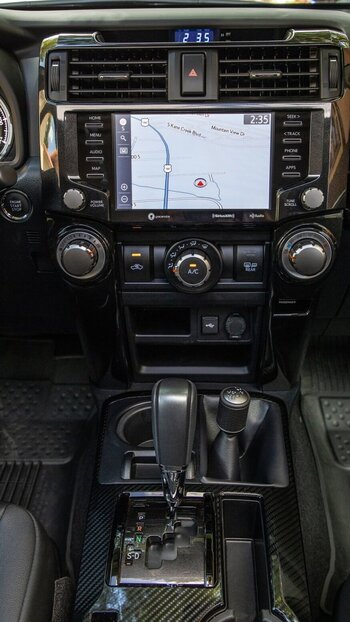
7. The footrest intrusion on the right-hand footwell. It is not as bad as some online reports indicate, but it is far from ideal. If the passenger wants to place their left foot on the footrest, it is quite comfortable (but is not symmetrical). However, if the passenger wants to stretch out both legs - which is necessary on long drives - they cannot sit straight, but rather, have to pivot in the seat (to the right) so that they are sitting off-center (I am 6' 2" tall). On Thursday, I skied uphill (and down) over 11,000 vertical feet. On Friday morning my legs were a little fatigued, and that was before I drove five hours to get to the Grenadier driving event. I sat in the passenger seat with both legs stretched out, and it didn't take long to start feeling uncomfortable. That's my experience - yours may differ. Its hard to really see in the photos, but here you go:
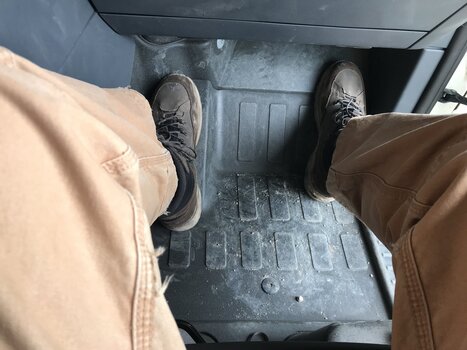
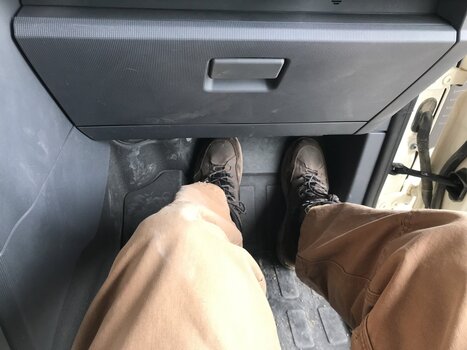
Disclaimer for the easily offended: my impressions of the Grenadier are mine alone
The staff was great: professional, knowledgeable, and friendly.
The course was good - but not great. There was a 35-37 degree side-slope, a couple of short steep hills to both climb and descend, some tight turns, but nothing very technical. It was a more challenging course than most manufacturers would embrace, but if you regularly drive off-road in Colorado, this was about a 4 on the OnX Off Road scale from 0-10.
Here are my impressions. These may - or may not - be relevant to you. You may - or may not - use your off-road vehicle the same way that I do.
Positive impressions:
1. The Grenadier handled it all very well, and felt very planted - especially on the side slope.
2. The suspension is fantastic. Wheel travel is good, it articulates well, and the springs and shocks work well together to mitigate rough terrain. The Grenadier is comfortable and quiet off-road.
3. The steering felt precise off-road. We were in 4-low the whole time, and never got up to speed, so I cannot speak to on-road driving characteristics.
4. The B58 (gas engine) has excellent low-end torque, and is easy to modulate in low-range. This engine will out-perform all naturally aspirated 6-cylinder engines here at altitude. To compete at altitude, Jeep desperately needs an option for a forced induction 6 in the Wrangler/Gladiator, and Toyota needs a better powerplant for the Tacoma/4-Runner.
5. This little truck is solid. (a) The frame resembles that of a heavy duty pickup (e.g. Ford F250, Ram 2500); (b) The running gear (tie rod, drag link, track bar) resemble what you would see on a solid front axle Landcruiser - much beefier than a Jeep Wrangler, but not quite as stout as a heavy duty truck; (c) the axles are beefier than a Jeep Wrangler, but less stout than a heavy duty truck.
6. All moving parts in the body are aluminum (hood, four side doors, two rear doors). All the doors feel well-made, and close with a satisfying feel, that speaks to how well-sealed they are against the elements.
Not-so positive impressions:
1. I would have liked to engage and disengage the lockers, and I would have liked to shift in and out of 4-low. This was not permitted.
2. Given its clear intention to be a rugged 4x4, the Grenadier has good - but not great ground clearance. Most drivers were hitting the rear differential on a rock that wasn't very big (in Colorado, we regularly travel through much more rocky terrain). The Ineos guides requested that people either take it very slow, or place a tire on the rock (as opposed to straddling it). Placing tires on top of rocks is basic off-roading, but on harder trails, you need better ground clearance. If the Grenadier were more easily modified, this would not be a concern. However, as discussed in multiple threads on this forum, the Grenadier will not take well to larger tires for the following reasons: (a) short control arms, (b) lack of re-gearing options for the Carraro axles, and (c) a split rear door that will not accommodate a tire larger than 33-inches in diameter. Some - or all - of this may get addressed in the aftermarket.
3. Engine braking going down steep hills is good, but not great. For my style of off-road driving, I would prefer a lower, low range. The Grenadier has a low range of 2.5:1, whereas as a Wrangler Rubicon has a low-range of 4:1. The Rubicon transfer case is better-suited to technical off-road driving in Colorado. The Grenadier transfer case will be better for sand, and higher speed off-roading while still needing low-range.
4. For an off-road vehicle - the gear selector is awful. The haptics do not provide the simple and tactile feedback required in a true off-road vehicle. A gear selector in a 4x4 needs to (a) move, so that shifting is positive, and can be verified by both feel and sight, (b) positively engage with gears, and (c) not be prone to shifting out of gear with a moderate tap or bump - which can happen while off-roading. The BMW gear selector fails on every count. To put it into park, you press a button on the gear selector; nothing moves, and there is no confirmation of being in park, other than a little light on the dash. To put it in drive, you press a button and pull back; the selector pivots backward, then returns to its regular position. There is no visible sign of what gear you are in, other than a little light on the dash. To go into "manual mode" you tap it to the left - but again, it pivots, but does not move over to the left - so there is no good feedback. In manual mode, you can up-shift by tapping rearwards, or down-shift by tapping forwards. If your tap to the left did not actually put the vehicle in manual mode, then - if you forward tap (thinking you are downshifting) - you will put the truck into neutral, and you will suddenly lose all engine braking. The gear selector completely fails to match other components in the Grenadier - which are rugged, and positive in their engagement. The Jeep Wrangler and Gladiator use the same ZF transmissions as the Grenadier, but have a far superior gear selector. It moves and then positively engages whatever gear you select, and moves when you shift to manual mode. Everyone is entitled to their opinion - this is mine.
5. Tim (the Ineos representative from England, who was in charge of discussing the undercarriage), said that the axles were semi-float, not full-float. If you are unfamiliar with this terminology, here is a good resource: Full-Floating vs Semi-Floating Axles. For 2024, Jeep is offering full-float axles as an option in the Wrangler, and all heavy duty trucks have full-float axles, so this was a disappointment.
6. This is a minor issue, but people talk a lot about how the HVAC controls are "big and chunky". To me, they are not that big, and do not stick-out that much from the dash, and will not be that easily adjusted with gloves. Here is an example of HVAC controls, from a Toyota 4-Runner, that can be easily adjusted wearing winter gloves; the photo also provides an example of a gear selector that moves, and positively engages into gear:

7. The footrest intrusion on the right-hand footwell. It is not as bad as some online reports indicate, but it is far from ideal. If the passenger wants to place their left foot on the footrest, it is quite comfortable (but is not symmetrical). However, if the passenger wants to stretch out both legs - which is necessary on long drives - they cannot sit straight, but rather, have to pivot in the seat (to the right) so that they are sitting off-center (I am 6' 2" tall). On Thursday, I skied uphill (and down) over 11,000 vertical feet. On Friday morning my legs were a little fatigued, and that was before I drove five hours to get to the Grenadier driving event. I sat in the passenger seat with both legs stretched out, and it didn't take long to start feeling uncomfortable. That's my experience - yours may differ. Its hard to really see in the photos, but here you go:


Disclaimer for the easily offended: my impressions of the Grenadier are mine alone
Last edited:
I’m curious about all the restrictions they are placing on US drive days - no pics or videos of the interior, no changing in or out of low range, taking safer lines etc. Whilst our drives weren’t as long as yours seem to be (at least here in Queensland) we had no restrictions for any of the above. For example I’ve got video of the full drive from the back seat, dozens of internal pics, and could take any line to test capability I wanted.
Maybe it’s a liability thing given your well known national litigious character??
Maybe it’s a liability thing given your well known national litigious character??
Possibly an insurance issue alsoI’m curious about all the restrictions they are placing on US drive days - no pics or videos of the interior, no changing in or out of low range, taking safer lines etc. Whilst our drives weren’t as long as yours seem to be (at least here in Queensland) we had no restrictions for any of the above. For example I’ve got video of the full drive from the back seat, dozens of internal pics, and could take any line to test capability I wanted.
Maybe it’s a liability thing given your well known national litigious character??
On my Perth drive I had Justin Hocevar in with me and he was having a bit of fun and just telling me to go for it.
Didn't even stick to the tracks towards the end.
Then on the long tar straight he told me to drive as fast as I wanted, without hitting the chicane bollards, then stand on the brakes to see how well it stopped.
Good to see the man in charge enjoys the job
The drives are by no means long. I think they are 15 minutes, and you technically could only get half of that if there are enough drivers.
I agree with what Stickshifter wrote.
I always get flustered in situations like that- I don’t want to hold people up and get off ‘content’. While Tony would probably been more than happy to sit in the car and go over the 4WD system more, I only availed myself of small things. I was starting to wonder I messed up by not getting out of low gear- but that was by design. It is more of a demonstration than a true test drive. I chastised myself for not seeking out the Selma green model- but I guess there wasn‘t one? Just a Jerry can?
I don’t like the BMW stick and I agree, the Jeep implementation of the same transmission is far more standard. The stick will take some getting used to. In the off-road mode, there is a big indicator of gear selected.
No rational person would by an IG based on the delivery experience in the EU so far, the lack of production models here in the states, and the lack of real test drives. It frankly is a pig in a poke.
I am a highly rational person, chemist by training, and I have never made a ‘bad’ decision- I’m not saying that they all worked out like I wanted- but even in hindsight I did the ‘smart’ or best thing.
My wife balked at going to the event after I filled her in the history- She is somewhere between ‘vaporware’ and ‘dumpster fire’.
Like I said, no rational person would by one. Luckily most consumers aren’t rational.
I agree with what Stickshifter wrote.
I always get flustered in situations like that- I don’t want to hold people up and get off ‘content’. While Tony would probably been more than happy to sit in the car and go over the 4WD system more, I only availed myself of small things. I was starting to wonder I messed up by not getting out of low gear- but that was by design. It is more of a demonstration than a true test drive. I chastised myself for not seeking out the Selma green model- but I guess there wasn‘t one? Just a Jerry can?
I don’t like the BMW stick and I agree, the Jeep implementation of the same transmission is far more standard. The stick will take some getting used to. In the off-road mode, there is a big indicator of gear selected.
No rational person would by an IG based on the delivery experience in the EU so far, the lack of production models here in the states, and the lack of real test drives. It frankly is a pig in a poke.
I am a highly rational person, chemist by training, and I have never made a ‘bad’ decision- I’m not saying that they all worked out like I wanted- but even in hindsight I did the ‘smart’ or best thing.
My wife balked at going to the event after I filled her in the history- She is somewhere between ‘vaporware’ and ‘dumpster fire’.
Like I said, no rational person would by one. Luckily most consumers aren’t rational.
CrikeyThe drives are by no means long. I think they are 15 minutes, and you technically could only get half of that if there are enough drivers.
I agree with what Stickshifter wrote.
I always get flustered in situations like that- I don’t want to hold people up and get off ‘content’. While Tony would probably been more than happy to sit in the car and go over the 4WD system more, I only availed myself of small things. I was starting to wonder I messed up by not getting out of low gear- but that was by design. It is more of a demonstration than a true test drive. I chastised myself for not seeking out the Selma green model- but I guess there wasn‘t one? Just a Jerry can?
I don’t like the BMW stick and I agree, the Jeep implementation of the same transmission is far more standard. The stick will take some getting used to. In the off-road mode, there is a big indicator of gear selected.
No rational person would by an IG based on the delivery experience in the EU so far, the lack of production models here in the states, and the lack of real test drives. It frankly is a pig in a poke.
I am a highly rational person, chemist by training, and I have never made a ‘bad’ decision- I’m not saying that they all worked out like I wanted- but even in hindsight I did the ‘smart’ or best thing.
My wife balked at going to the event after I filled her in the history- She is somewhere between ‘vaporware’ and ‘dumpster fire’.
Like I said, no rational person would by one. Luckily most consumers aren’t rational.
Never made a bad decision??
I recall waking up next to quite a few bad decisions before I met my wife.
Also purchased some cars I shouldn't have, taken jobs that I quit not long after, stayed for just one more drink when I should have left and made some pretty doubtful wardrobe(clothing combinations) decisions.
It's been a life full of good, bad and ugly decisions but it has been one hell of a life so far.
As they say 60 is the new 40 so hopefully many more dubious choices and bad decisions to come.
What color is the light truck?
Scottish White. IMO MM is far too dark to order. It’s like a dark taupeWhat color is the light truck?
Had a great time at the Colorado Springs event today. Snow on the course was a blast.
Love that Shale Blue..
What is all that white stuff on the ground??
Shale Blue is beautiful in person. It’s either that or Britannia BlueLove that Shale Blue..
What is all that white stuff on the ground??
Last edited:
You forgot to mention your humility.I am a highly rational person, chemist by training, and I have never made a ‘bad’ decision- I’m not saying that they all worked out like I wanted- but even in hindsight I did the ‘smart’ or best thing.
Don’t worry, I’ve been making your quota of bad decisions after exhausting my allocation years ago.
Don’t worry, I’ve been making your quota of bad decisions after exhausting my allocation years ago.
Hold up... we were allowed to make good ones?!
Yep - you can buy a Grenadier
Hold up... we were allowed to make good ones?
Yet another in a lifetime of decisions made at the intersection of intuition and curiosity.Yep - you can buy a Grenadier
Yep - you can buy a Grenadier

You never should have married the dumpster fire. Although people can change...The drives are by no means long. I think they are 15 minutes, and you technically could only get half of that if there are enough drivers.
I agree with what Stickshifter wrote.
I always get flustered in situations like that- I don’t want to hold people up and get off ‘content’. While Tony would probably been more than happy to sit in the car and go over the 4WD system more, I only availed myself of small things. I was starting to wonder I messed up by not getting out of low gear- but that was by design. It is more of a demonstration than a true test drive. I chastised myself for not seeking out the Selma green model- but I guess there wasn‘t one? Just a Jerry can?
I don’t like the BMW stick and I agree, the Jeep implementation of the same transmission is far more standard. The stick will take some getting used to. In the off-road mode, there is a big indicator of gear selected.
No rational person would by an IG based on the delivery experience in the EU so far, the lack of production models here in the states, and the lack of real test drives. It frankly is a pig in a poke.
I am a highly rational person, chemist by training, and I have never made a ‘bad’ decision- I’m not saying that they all worked out like I wanted- but even in hindsight I did the ‘smart’ or best thing.
My wife balked at going to the event after I filled her in the history- She is somewhere between ‘vaporware’ and ‘dumpster fire’.
Like I said, no rational person would by one. Luckily most consumers aren’t rational.
For reference, PTO2 #73 is MM. That's the one I drove at the Phoenix event.What color is the light truck?
Yes you’re right, my mistake. Did you find it dark?For reference, PTO2 #73 is MM. That's the one I drove at the Phoenix event.
Similar threads
INEOS Corporate/Dealer Event
Triad Ineos Grenadiers & Grit: BEACH EDITION - April 18th and 19th 2025 | Fort Fisher & Wilmington, NC
- Replies
- 2
- Views
- 132
INEOS Corporate/Dealer Event
GRENADIER DEMO DAYS: APRIL 12 & 19 (PASADENA, CA)
- Replies
- 0
- Views
- 271
- Replies
- 5
- Views
- 505
- Replies
- 17
- Views
- 764
- Replies
- 13
- Views
- 1K

